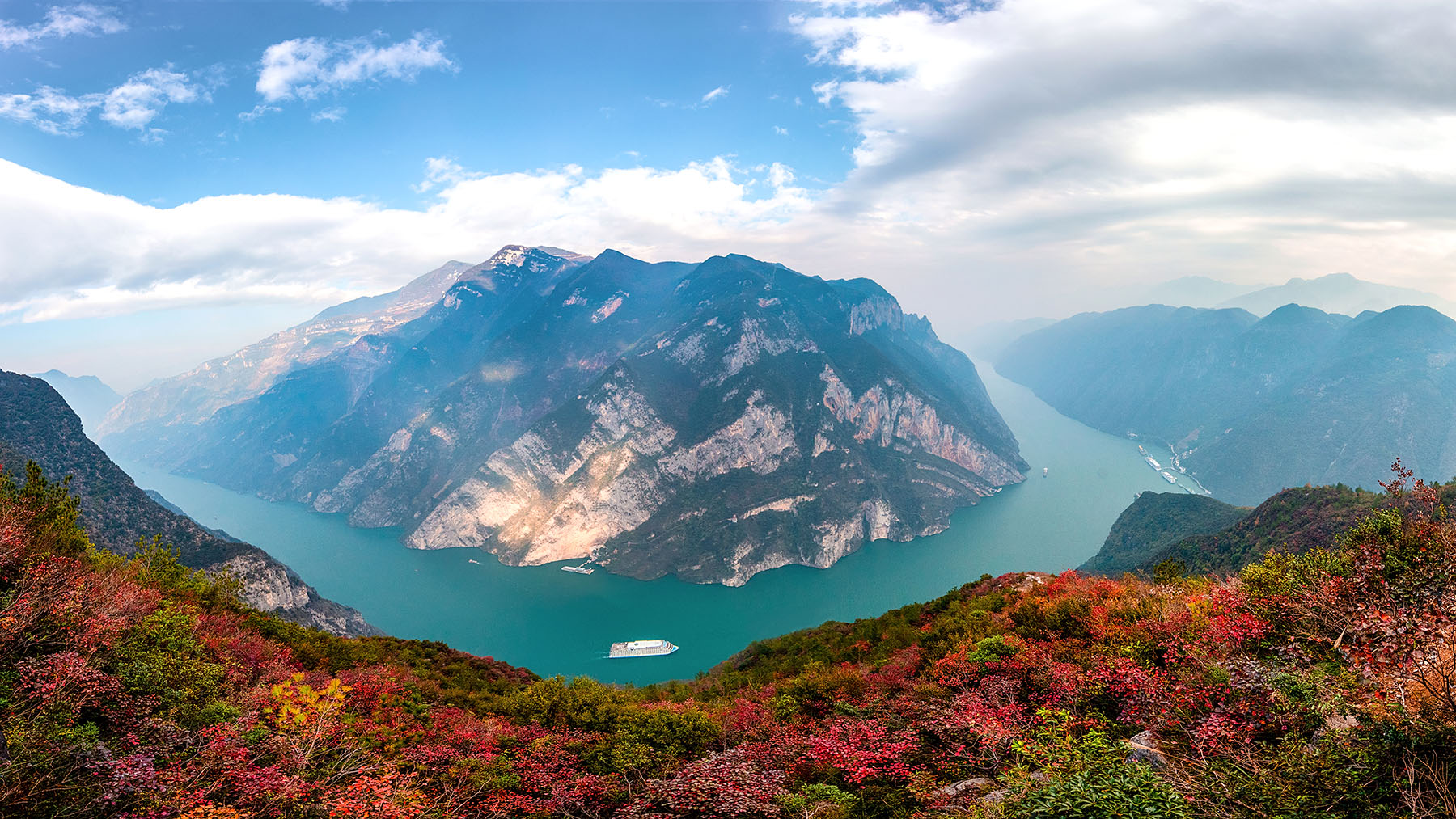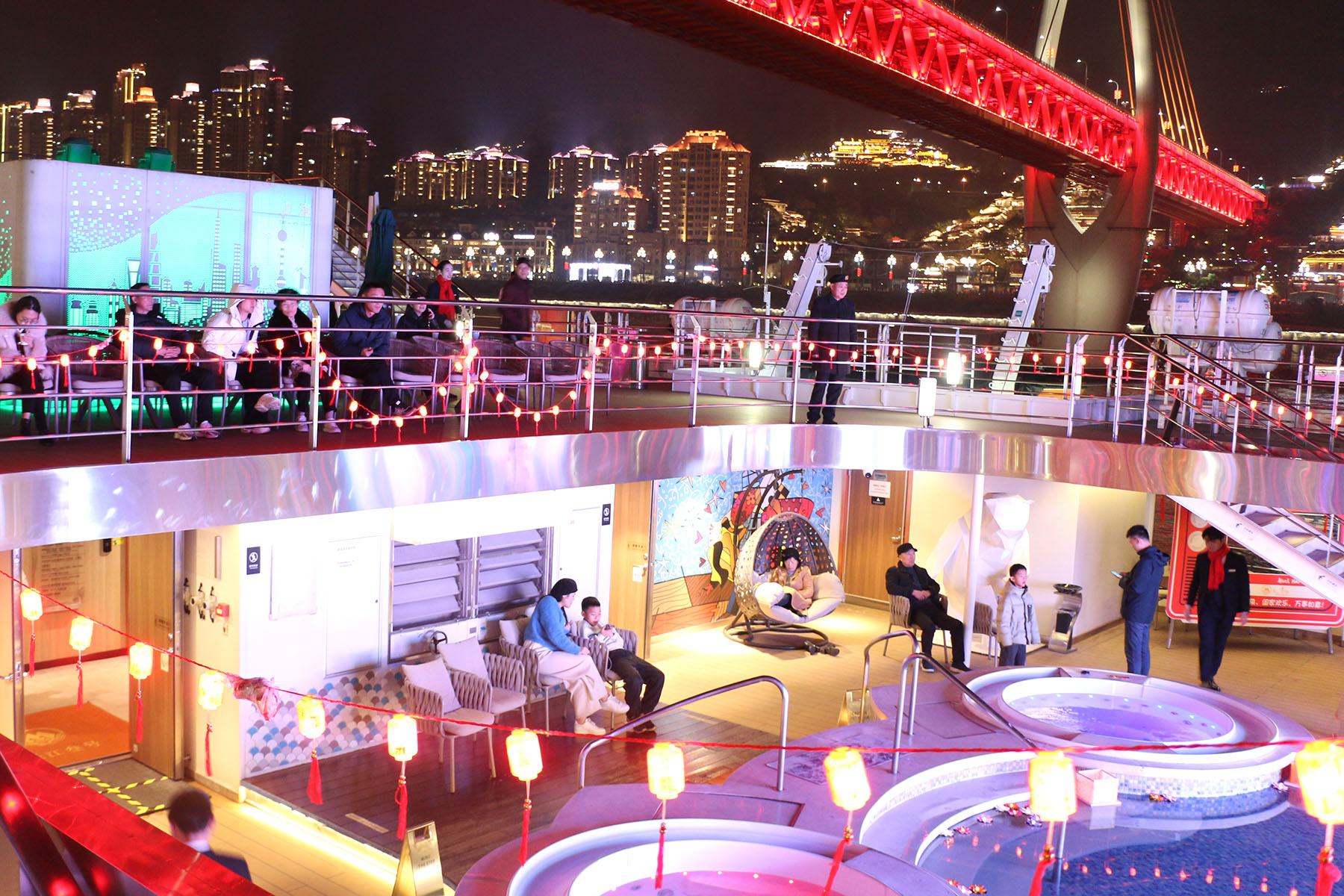Travelers experience the Yangtze River's vast cross-provincial landscapes by sailing on tourist vessels, Xu Lin and Liu Kun report in Yichang, Hubei.

To truly embrace the Yangtze River's majesty and immerse in its inspiring landscapes, you must embark on a cross-provincial scenic cruise. The upstream voyage along the Yangtze River from Yichang city in Hubei province to Chongqing municipality takes five days and four nights, tracing the river's picturesque view through the Three Gorges.
Travelers will savor gourmet buffets, revel in onboard entertainment, and join guided land excursions when the cruise ship docks.
Guests will board the cruise ship in the evening at Maoping Port in Yichang. The next day, they will explore the city before the vessel departs the following evening.
At the Tribe of the Three Gorges scenic area in the Xiling Gorge, tourists experience the Tujia ethnic group's folk singing and spirited dancing, witness traditional wedding customs, and observe fishermen wrangling their catches on old wooden boats.
READ MORE: Sustainability key to new Yangtze River revenue stream
As for how ships traverse the Three Gorges Dam, there is a vivid motto: "Large vessels climb stairs; small ships ride the elevator." Large cargo ships and some cruise vessels line up to pass through the dam's five-tier ship locks, which can take up to four hours.
Visitors can temporarily transfer to smaller daily tourist ships for an immersive experience, as the ship traverses the dam from downstream to upstream, ascending vertically by up to 113 meters.
This feat is made possible by the world's largest vertical-hoisting ship lift, designed for small and medium-sized vessels. Within 40 minutes, this engineering marvel lifts a vessel using high-precision sensors, driving devices, and an advanced control system.
As the vessel slowly glides into the 18-meter-wide and 120-meter-long chamber, the water level rises and the cruise ship ascends to its maximum height within 10 to 12 minutes.
Standing on deck, guests are amazed by the colossal dam that unfolds before them, with endless mountain vistas stretching across the horizon — a powerful testament to human ambition meeting natural grandeur.
Such daily cruises showcase "Two Dams and One Gorge", referring to the Gezhouba Dam, the Three Gorges Dam and Xiling Gorge.
"Tourists enjoy the enchanting view of Xiling Gorge on Yichang's daily cruises. They watch cultural performances on board that integrate the heritage of the Yangtze River. China's upgraded visa policies have also ignited a surge in overseas visitors," says Luo Biao, deputy manager of the marketing center of the tourism development division at Hubei Three Gorges Tourism Group.
On day three, after a night of sailing, the cross-provincial cruise ship enters the Wuxia Gorge at dawn, drawing visitors to the deck, where the 12 peaks of Wushan Mountain rise along the banks of the Yangtze River in Chongqing's Wushan county, with six peaks on each side.
The most legendary is the Goddess Peak said to be the incarnation of the goddess Yaoji, the Chinese Goddess of Love. She also serves as a symbolic guardian for people hoping for safe sailing journeys through turbulent currents.
As tourists gaze up from the cruise ship, the slim Goddess Peak emerges like a divine maiden, often cloaked in a mysterious mist, especially during the rainy season.
Numerous poets throughout history have been inspired by these scenes and depicted the mountain's precipitous cliffs, mythical legends of the goddess, and their reflections on life and travel in their time-honored poetry masterpieces.

Nature's craftsmanship
A 40-minute drive along winding mountain roads takes visitors to the Heart of the Three Gorges observatory. The vantage point unveils a naturally shaped heart formed by the river and mountain ridges and a panoramic view of nine of Wushan Mountain's 12 peaks. The view echoes Song Dynasty (960-1279) poet Lu You, who wrote a poem about seeing nine peaks from a boat on the Yangtze River.
"After it rains, the mountain exposes dual wonders," says Xiang Ping, a veteran tour guide from Wushan county.
"Mist-cloaked peaks form a mysterious atmosphere and the verdant hills mirror the crystal-clear water as rain washes away any dust and sharpens their colors. Each time you visit, you may encounter a different scene."
Hiking trails, such as the path on the Flying Phoenix Peak, draw ardent fans. From late November to early December, Wushan Mountain is ablaze with red foliage, a testament to nature's craftsmanship.
In the afternoon, the cruise ship arrives at the 8-kilometer-long Qutang Gorge, the shortest section of the Three Gorges.
Visitors enjoy the stunning scenery of Kuimen Gate, the very landscape printed on the back of China's 10 yuan ($1.4) banknote. The gate, a strategic gateway to Qutang Gorge, has commanded great military significance since ancient times. Its narrow cliffs and perilous currents create an impassable natural terrain that builds a fortress to contain the Yangtze's upper reaches.
Chongqing's Fengjie county has gained its reputation as "the poetry city of China" due to the countless poems depicting the formidable landscape of Kuimen Gate and Qutang Gorge, and the region's rich folk customs.
Tang Dynasty (618-907) poet Du Fu resided in Kuizhou (today's Fengjie) for about two years. Despite battling chronic illnesses and financial challenges, he composed over 430 poems, which marked a prolific peak in his literary career.
In Kuizhou, he climbed to the top of the White Emperor City and penned a literary gem, giving voice to his exile's bitterness in old age, unfulfilled ambitions, solitude, and a homeland in turmoil.
Today, cruise ship guests can go on the shore and ascend the White Emperor City's 365 steps, capturing different perspectives of Kuimen Gate.
On day four, the vessel docks at the Fengdu Ghost City scenic area on Mingshan Mountain in Fengdu county, the last destination before arriving at Chongqing's Chaotianmen Port the next morning.
Song Dynasty scholar Su Shi once climbed the mountain, considered an auspicious place of Taoism, and wrote a poem hailing its scenery.
Ancient Chinese people believed that souls journeyed to the netherworld after death, which was embodied by the ancient temples, halls, and sculptures of judges in hell, in the ghost city.

Linking cultural attractions
With increasing popularity among tourists from both home and abroad, the Three Gorges area has witnessed improvement in tourism infrastructure.
"The Three Gorges Dam has improved the navigation conditions between Yichang and Chongqing," says Wang Zan, captain of the Yangtze 3 cruise ship, a luxury vessel that travels between the two cities.
"Under China's strict environmental protection regulations, the river's water quality is good and the public's awareness of environmental protection has grown markedly," he says.
According to him, advanced navigation systems, such as radars, ensure cruise safety via real-time monitoring. In the past, piloting relied heavily on manual skills due to the lack of such technical assistance.
Ships were once vital for mass, low-cost transport across the Yangtze River region. However, high-speed rail, highways and aviation have gradually rendered passenger ships obsolete as people prioritize speed and convenience.
"Interprovincial passenger ships on the Yangtze River largely ceased operations around 2000. After that, companies began renovating passenger vessels into tourist cruises and building new cruise ships," says Chen Xilong, deputy general manager of Chongqing Changjiang Shipping Co Ltd, which operates the Yangtze 3.
ALSO READ: River cleaners keep Yangtze waters clear
According to Chen, compared with other overseas river cruise ships, current Yangtze River cruises feature longer sailing routes that link mountains, cultural attractions and cities, appealing to tourists who want colorful experiences both on board and on shore.
He says Yangtze River cruise ships are larger than their overseas counterparts, offering more space and superior facilities, reaching world-class standards.
"Most passengers on Yangtze River cruise ships are domestic tourists. The market boasts great potential due to China's massive population and robust consumption power," he says.
As for challenges, Chen says that port and wharf infrastructure must be upgraded and, with the Yangtze River spanning multiple regions, promotional efforts due to inadequate cross-provincial coordination must be addressed.
Zhou Lihua contributed to this story.
Contact the writers at xulin@chinadaily.com.cn


